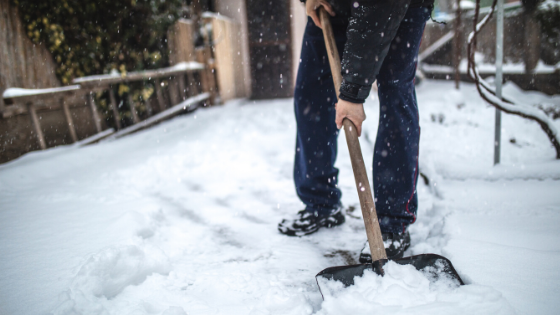
The winter months usher in a myriad of fun seasonal activities: skiing, sledding, ice skating, and snowshoeing. On the other hand, unpredictable weather and bitterly cold temperatures mean a lot of hard work, and unfortunately, unexpected injuries. In 2018, nearly 200,000 Americans ended up in emergency rooms and doctors’ offices, with sprains, strains, dislocations and fractures, according to the U.S. Consumer Product Safety Commission. Most of these injuries were the result of overexertion, a lack of preparation and not acknowledging their body’s warning signs.
Winter chores, from scraping ice off the windshield to snow shoveling, can wreak havoc on the human body and cause injury and pain. Of the 200,000 winter-related injuries, more than 11,000 were caused by shoveling snow, with soft tissue damage and lower back being the most common ailments, a figure from the American Journal of Emergency Medicine. Snow removal is strenuous and can be a serious safety hazard. Slick, ice-covered sidewalks, driveways and stairs make people of all ages vulnerable to slips and falls.
Now imagine doing this work with a lower limb condition. For someone with osteoarthritis or diabetic foot conditions, a custom-made or prefabricated orthosis helps accommodate a great deal of discomfort and irritation. In particular, the Varum-Valgum Adjustable Stress, or V-VAS™, custom unloader knee orthosis increases the effectiveness and compliance for an individual with its unique capabilities.
V-VAS utilizes a total contact cuff on the polypropylene plastic anterior thigh and calf, along with an adjustable self-aligning polycentric joint system to create four points of pressure instead of three. This very patented and practitioner friendly design simulates an ideal bending moment that results in the precise offloading and realigning experience. In other words, it’s going to make shoveling snow a whole easier with reduction of pain.
Whether you’re suffering a lower extremity condition or looking for a less strenuous way to remove snow, Anatomical Concepts, Inc. digs deep to give you tips and techniques to help prevent injury and avoid a trip to the hospital.
First and Foremost: Choose Your Shovel Wisely
Finding the snow shovel that best suits you can feel more like the story of Goldilocks and the Three Bears. A tall individual with a small shovel will encounter frequent bending and lifting, while someone shorter with a long shovel will feel overwhelmed and not able to leverage it properly.
When shovel shopping, take into consideration your height and strength. It’s essential to “test drive” the product before making a purchase. Grab the shovel handle and see how it feels in your hands. Is it balanced and comfortable? A curved or adjustable handle length will help minimize painful bending.
Remember, no two shovels are the same. Shovels employ all kinds of materials: wood, plastic, fiberglass and metal. Some are designed specifically for pushing large amounts of snow with a large curved blade, while others are more of the traditional route for lifting from sidewalks and smaller areas.
We haven’t even mentioned snow blowers. These machines make snow removal quick and easy. But remember to watch where you’re plowing, as snow and ice can result in bone injuries, including broken wrists, arms and hips.
If there’s one thing to take away here: a lightweight, ergonomic snow removal tool will make life a whole lot easier and help ease the burden of shoveling the white stuff.
Shovel as Soon as the Snow Starts
Don’t wait around for the snow to start piling up. Once the flakes begin falling, bundle up in layers and get outside. It’s easier to clear a few inches than a foot of snow. The Snow and Ice Management Association (SIMA) recommends clearing your driveway or sidewalk after an inch or two of accumulation. This ensures snow doesn’t freeze and become more difficult to scrape from the ground.
Let's Warm Up and Stretch
You wouldn’t just start exercising without warming up first. The aches and pains would be inevitable if that were the case. Shoveling snow is a high-intensity workout, engaging all of the major muscle groups: quads, glutes, biceps, triceps, back and abdominals. Before digging, it’s imperative to stretch, especially since your body will endure a dynamic range of motion. Arm circles, lunges and even marching in place help improve flexibility while increasing blood flow and body temperature.
It’s All About Technique
One of the most common mistakes people make when shoveling snow is employing improper form and technique. Do not overexert yourself by lifting and tossing snow. This action of removing snow involves a twisting motion that can cause injury to the back and lower extremities. Instead, push snow off to the side to reduce strain on your body.
If you are going to lift snow, there are a few style adjustments to reduce strain on the body. It can’t be stressed enough the importance of bending with the knees and lifting with your legs. Stand with your feet wide apart and one foot in front of the other to allow more motion to happen at the knees and hips versus the back.
As you’re digging, keep the shovel blade close to your body and switch off between shoveling right-handed and left-handed. Also, change the grip on the hand holding the bar, with palm under and palm over. This type of consistency ensures all muscles receive the same TLC.
Find Your Perfect Stride
No one knows your body better than you do. Be aware of the signals. If you’re feeling fatigued or muscle discomfort, don’t push it. Stop and take a break from shoveling. Snow removal is a strenuous job that requires frequent breaks and a lot of fluids to avoid becoming dehydrated.
Anatomical Concepts is accomplished in treating people with lower and upper extremity impairments. Our professional staff, coupled with state-of-the-art orthotics, treats your condition effectively and efficiently to get you back in action.
 330-757-3569
330-757-3569




